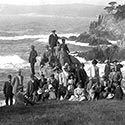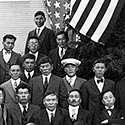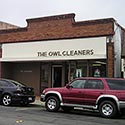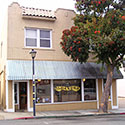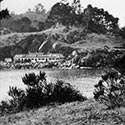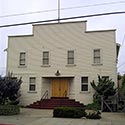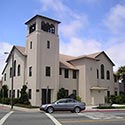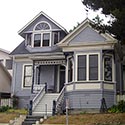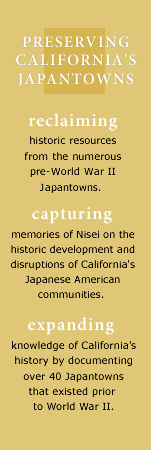 |
MontereyAbundant marine resources were the economic engine for many of the Monterey peninsula’s diverse communities, including Japantowns in the area. Japanese presence in the Monterey area dates to the 1890s and quickly centered on maritime activities. Japanese immigrants entered local fishing and packing industries, as well as fresh fish markets. By the late 1930s, eight Nikkei-owned fishing companies occupied key spaces on Fisherman’s Wharf and Sea Pride Cannery operated on Cannery Row. Some Japanese immigrants took to truck farms that supplied vegetables to markets throughout the peninsula, while others established small businesses that served fellow immigrants and non-Nikkei. By 1920, a concentrated Japanese community appeared in downtown Monterey and a smaller second enclave had settled in the "New Monterey" neighborhood near the canneries. ›› CLICK TO ENLARGE.
PROFILES
| ||||

The Monterey peninsula's spectacular coastline was a place for Japanese immigrants to make their livelihood and enjoy communal recreation as this 1909 image of Issei at Pt. Lobos illustrates. Annual picnics organized by the Japanese Association brought the entire community together for a day of food, games and celebration. Photo courtesy of the Kodani family.

Pt. Lobos Canning Company. A young marine biologist from Japan, Gennosuke Kodani, led the establishment of the local abalone fishing and processing industry, and introduced modern diving equipment to the area. By 1898, Kodani and landowner Alexander Allan began the Point Lobos Canning Company, which harvested, dried and shipped abalone to Japan and China. The Kodani home, a guest house and a bunkhouse for Japanese laborers formed a center for activity across Whalers Cove from the cannery until 1933, when the State of California purchased the land from Allan to create Point Lobos State Reserve. Although the buildings no longer stand, pine and cypress tress planted by Gennosuke and his wife, Fuku, still frame the view towards the cannery site. And visitors to the Monterey Bay Aquarium can see remnants of the former Sea Pride Cannery, owned by Tsunetaro Oda and K. Kiino, in the Outer Bay exhibit wing. Visitors to the Monterey Bay Aquarium's Outer Bay Exhibit stand on the site of Sea Pride Cannery, founded in 1925 by Tsunetaro and Zenichiro Oda, K. Niino, and Harry Suzukawa. The cannery’s warehouse now holds shops and restaurants across the street.Photo courtesy of the Kodani family.

Monterey's Japanese Association Hall was constructed by local community leaders with additional financial support from the Japanese Crown Prince Asaka, who had been impressed by the reception given his 1925 visit to the area. In addition to serving as meeting space for the Association, the hall hosted weddings and funerals, community entertainment and the first Japanese language school on the Monterey Peninsula. By 1940, eight organizations listed 424 Adams Street as their address, including a women's group, a judo club, and the Young Buddhist Association. The Hall hosted the last regional convention of the Japanese American Citizens League prior to WWII, during which members discussed and debated their increasingly fraught relationship to the US government and the impending war. Shortly after Pearl Harbor, the Japanese Association transferred title to this property to the local Japanese American Citizens League in order to keep the structure within the Nikkei community. Photo courtesy of the Oda family.

Monterey's Nihonjinkai (Japanese Association), which began in 1908, constructed this community hall in 1926 on Adams Street between the Higashi Hotel and Yokohama Laundry. While the first floor is primarily devoted to a large hall with raised stage where traditional Kabuki theater was performed and Japanese language movies screened, classrooms take up much of the second story. The Hall was used as a National Guard Armory during the war, and as a hostel for returning Nikkei in the post-war period. This structure is one of the few pre-war JACL Halls found by our Preserving California's Japantowns survey that still provides a gathering place for the Nikkei community.

Fujiko Kodama purchased a dry-cleaning business in 1920, making Owl Cleaners the first establishment of this type run by Japanese immigrants in the Monterey region. George Kodama recalled that his mother "bought the business and went into it on her own. And she got so busy that she just couldn't handle it herself, so it forced my father to give up his fish market business and get into the cleaning business." By 1929, Owl had moved to this location on Webster Street, where it was run by two generations of the Kodama family until they sold the business in 1986. Before WWII, the heart of Monterey's Japantown sat a few blocks south and by 1940 included two general stores, a cleaner, a hotel, three restaurants, two insurance offices, a beauty shop, barbershop, three pool halls and bathhouses, an art goods store and a net shop. All of these structures appear to have been destroyed by post-war redevelopment.

The Japanese Church of Christ was established in 1912 as a ministry associated with missionaries in Carmel and the San Jose Presbytery. The church first operated out of a modest wooden structure on Washington Street in Monterey's Japanese and Chinese residential area. As families and the congregation grew, a Christian Gakuen (Japanese language school) was established in 1924 and the church made plans for a new building. The congregation marked groundbreaking with a procession from Washington Street to the new location at the corner of El Estero and Pearl Streets. Dedicated in 1926, the church led to the establishment of a Japanese residential neighborhood in the surrounding blocks. As anti-Japanese sentiment became more pronounced in the early 1940s, Presbytery leaders advised the congregation to consider taking the word "Japanese" from the church name, leading to the 1941 adoption of the name El Estero Presbyterian Church. The Church, which housed an African American congregation during WWII, was reclaimed when Nikkei returned from internment camp and still draws people from all over the region for its annual salmon dinner.

Although members of the Japanese American community were predominately Buddhist (as were the majority of Japanese immigrants), other traditions were practiced in Monterey. By the onset of WWII, a Nichiren Buddhist Church and the Shinto Association that met in this building were listed in community directories. Buddhist services were held at the JACL Hall from the 1920s until 1956 when a temple was constructed in nearby Seaside, with formal affiliation to Buddhist Churches of America, which oversees the majority of Japanese American Jodoshinshu churches in the United States.

Pacific Grove Cleaners has been owned and operated by the Uchida family since 1926, except for the years during WWII. Issei brothers Kakutaro and Onojiro Uchida were among the region's prominent early settlers. While Onojiro opened a general store and employment agency in Monterey's Japantown, Kakutaro and his family settled a short distance south in the coastal community of Pacific Grove. A mural on the side of this two-story building recalls the small group of Japanese Americans who lived and worked in Pacific Grove before WWII. Around the corner, the building where the Ichiuji family operated their shoe repair store, Grove Shoe Hospital, still stands at the intersection of Forest and Lighthouse Avenues.
